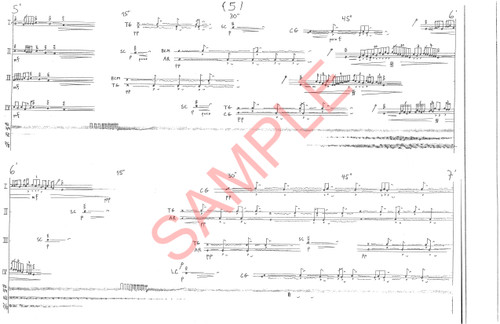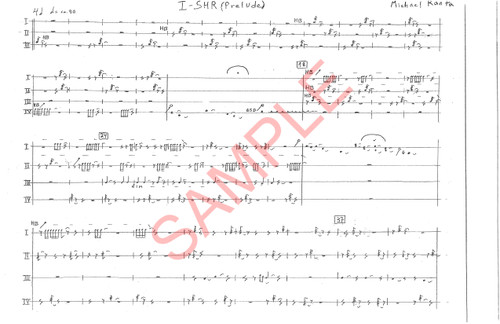Includes score and tape (CD). Four scores needed for performance.
Want it now? Click here to purchase a digital copy of this product.
Review from Percussive Notes (2021):
Yin–Chu from “Yuen Shan”
Michael Ranta
In 2015, Michael Ranta released a solo album titled Yuen Shan. It is comprised of four tracks, each being a work for a live percussionist and an eight-channel pre-recorded tape. Ranta and Media Press Music have now published all four of these pieces individually for percussion quartets to perform. This review will cover the first piece on the album, “Yin-Chu.”
The music itself is meditative. Through using the same sounds that the performers are making, the audio track sets the tone as the piece progresses from ethereal and calm, to raucous and chaotic, back down to a whisper. For the first eight minutes, the performers explore the sound possibilities of the gong. This includes striking it softly, scraping it with threaded dowels, and rubbing it with a rubber “superball.” After this, Ranta offers short episodes of interplay between the performers employing the wooden instruments and the metal plates. The performers return to the gongs with hard bell mallets as the music enters the loud and chaotic portion of the work. Once the dust settles from this bombardment of metallic sound, the players end the piece with the wooden timbres as they and the music gradually shrink into nothing.
“Yin-Chu” uses graphic notation, where the x-axis is time and the y-axis denotes who is making the sound. Ranta did a good job in giving a visual representation of the electronic audio, which makes it easier to follow during the almost 20-minute performance. Thanks in part to the instrumentation key at the beginning of the score, it is clear when instruments change, the kind of sounds that are desired, and the implement that the player is to use.
However, even with this key, there are questions that are left unanswered. For instance, even though the instrument list includes a slit drum, log drum, and bamboo tubes, none of these instruments are found in the score. This is also true for the balafon-blocks, or else they are mislabeled in the music, since there are two instrument labels in the score that are not represented on the key page. There may be answers to these questions in one of the other “Yuen Shan” works, but since all four are being sold individually, each should have accurate instrumentation lists so that these questions do not need to be asked.
Despite these questions, “Yin-Chu” is a beautiful work of contemporary music. When performed with the necessary patience and musical maturity, it can create a unique journey for listeners and performers.
—Kyle Cherwinski







